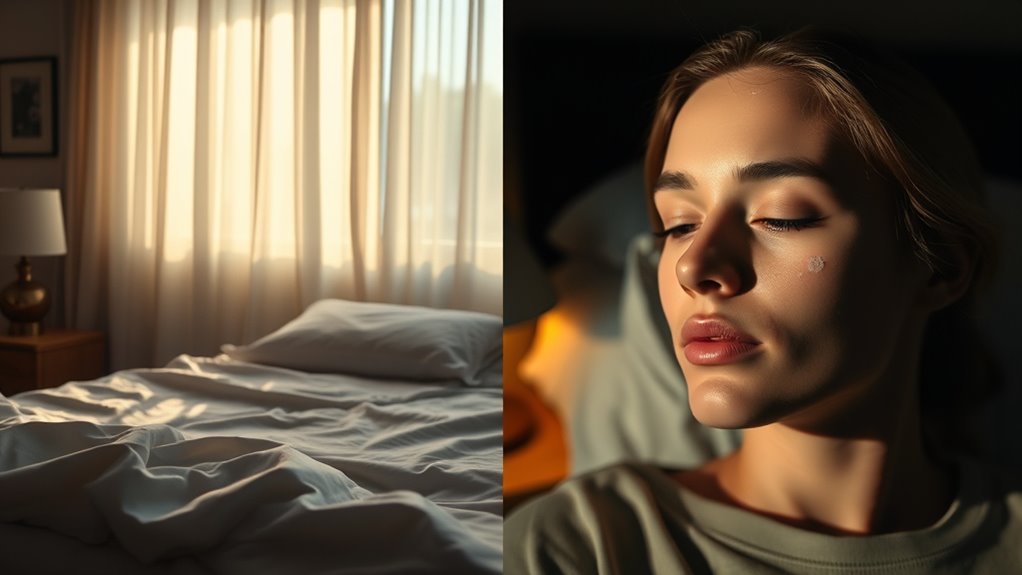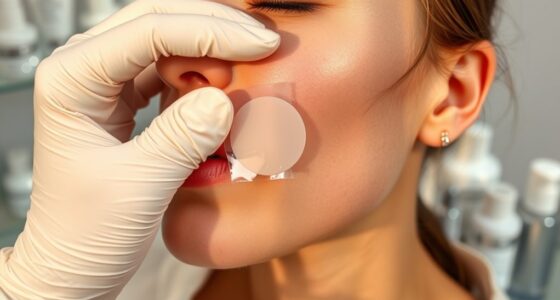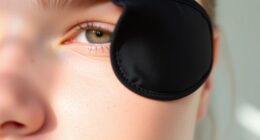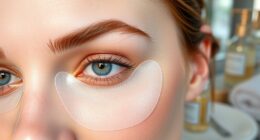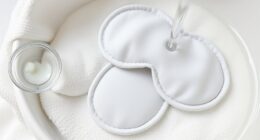For maximum acne patch effectiveness, applying it at night is your best bet. Nighttime allows for uninterrupted contact, better absorption of active ingredients, and taps into your skin’s natural healing cycle. During the day, sweat, dirt, and skincare products can block absorption and loosen patches. If you’re curious about why night use is superior and how to optimize your routine, keep going—more helpful insights are ahead.
Key Takeaways
- Nighttime application ensures undisturbed treatment, allowing active ingredients to penetrate deeply and work effectively during skin’s natural repair cycle.
- Day use exposes patches to sweat, oils, and pollutants, which can reduce adhesion and diminish medication absorption.
- Applying patches at night maximizes skin receptivity and minimizes external interference, boosting overall healing.
- Daytime use may be suitable for spot treatments in controlled environments but offers less consistent treatment conditions.
- Choosing the optimal time depends on your routine, patch type, and skin needs for maximum acne-fighting power.

Deciding whether to apply your acne patch during the day or at night can considerably impact its effectiveness. Your sleep routine plays a vital role in this decision, especially when considering how well your skin absorbs active ingredients. During the night, your body’s natural healing processes kick in, and your skin tends to be more receptive to treatments. When you place an acne patch before bed, you give it uninterrupted time to work, allowing the medication to penetrate deeply into the pores without interference from sweat, oils, or external pollutants. Plus, the cover of darkness minimizes the risk of disrupting your routine or accidentally rubbing the patch off during the day.
Applying your acne patch at night enhances absorption and healing by minimizing external interference.
Skin absorption is key when it comes to acne patches, which often contain medications like salicylic acid, benzoyl peroxide, or hydrocolloid gel. These ingredients need time and a stable environment to do their job effectively. At night, your skin’s porosity tends to be higher, especially during the repair cycle that occurs during sleep. This increased permeability enables the active ingredients to penetrate more thoroughly, making your treatment more efficient. When you apply the patch during the day, however, exposure to environmental factors like sweat, dirt, and physical contact can reduce its efficacy. Your skin may also be less receptive due to oil production or the presence of makeup and skincare products, which can create a barrier that inhibits absorption.
If you prefer to wear your acne patch during the day, it’s best to do so after thoroughly cleansing your skin and avoiding heavy makeup or skincare products that might interfere with adhesion or absorption. However, keep in mind that physical activity and heat can cause sweating, which might loosen the patch or dilute the medication, decreasing its effectiveness. During nighttime, you can guarantee a proper sleep routine by applying the patch on clean skin, allowing it to stay undisturbed for several hours. This uninterrupted period maximizes skin absorption and enhances the healing process.
Additionally, choosing the right type of patch can influence how well it works at different times of day, especially when considering filtration to keep your skin and environment clean. Ultimately, the choice depends on your daily schedule and skin’s needs. If you’re looking for maximum absorption and healing, applying your acne patch at night aligns with your body’s natural repair cycle and your sleep routine. This approach minimizes external interference, giving the medication the best chance to work deeply within your skin. Conversely, daytime application might be suitable for spot treatment when you’re in a controlled environment, but it requires more caution to maintain adhesion and effectiveness.
Frequently Asked Questions
Can Acne Patches Be Worn During Exercise or Sweating?
You can wear acne patches during exercise or sweating, but it depends on sweat resistance and patch adhesion. Look for patches specifically designed to stay in place despite moisture, ensuring they won’t slip off or lose effectiveness. If your patch has good sweat resistance and strong adhesion, it’ll keep working through your workout. Just make sure to follow the instructions and replace it if it starts to peel or lose stickiness.
Are There Any Side Effects of Wearing Patches Overnight?
Wearing acne patches overnight is generally safe, but you should consider patch safety to avoid overnight irritation. Some people might experience redness or dryness if the patch stays on too long or if their skin is sensitive. If you notice any discomfort, remove the patch and give your skin a break. Always follow the product instructions and consult a dermatologist if you’re unsure about potential side effects from prolonged use.
How Long Should I Leave an Acne Patch On?
You should leave an acne patch on for the ideal patch duration, which is usually 6 to 8 hours or overnight. Check the patch’s instructions for specific patch removal timing, as leaving it on too long might irritate your skin or cause discomfort. Typically, it’s best to remove the patch when it’s fully soaked with impurities or after the recommended time to maximize effectiveness without causing irritation.
Do Different Skin Types Require Different Patch Types?
Think of your skin as a garden; different plants need tailored care. Your skin sensitivity determines the patch type that suits you best, ensuring compatibility and reducing irritation. Just as some plants thrive with gentle watering, sensitive skin benefits from hypoallergenic patches. So, you should choose patches designed for your specific skin type, matching their properties to your skin’s needs for ideal healing without causing harm.
Can Acne Patches Be Used Alongside Other Skincare Products?
You can definitely use acne patches with other skincare products, but patch compatibility varies. For effective combination skincare, apply your patches after cleansing and before moisturizing or applying serums. Avoid layering thick creams or oils directly over patches, as this can reduce their effectiveness. Always check product instructions for specific patch compatibility tips, and give your skin time to breathe between applying different products for best results.
Conclusion
So, whether you opt to apply your acne patch at night or during the day, it’s all about fitting it into your routine. Think about when your skin needs the most protection or healing. Are you ready to harness the power of your acne patch whenever it works best? Remember, the right timing can make all the difference in achieving clearer skin. Why not try both and see what works best for you?
